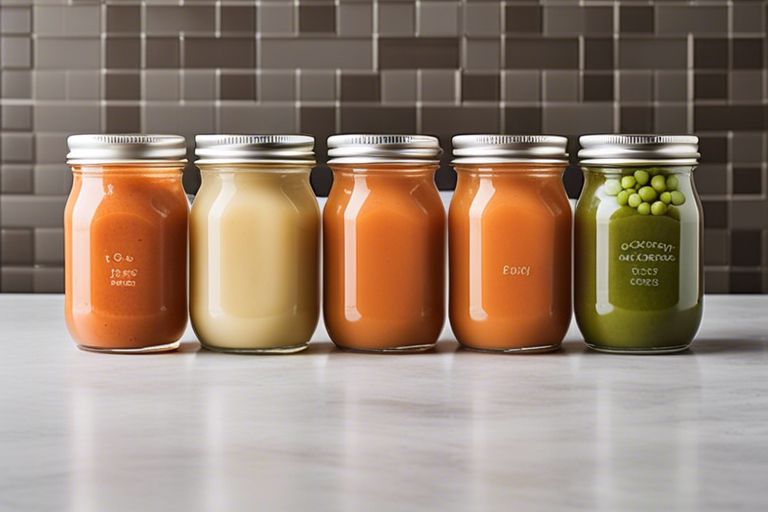tips, tricks and guides for parenthood
Most parents want to provide their little ones with the best nutrition possible, and making homemade baby food is a great way to ensure that. However, it's important to follow proper storage and preparation guidelines to prevent any dangers to your baby's health. Storing homemade baby food correctly can maximise its nutritional value and ensure it stays safe for your baby to eat. Let's look at some vital tips to safely store and prepare homemade baby food.
On your journey to making homemade baby food, there's some crucial kitchen equipment you'll need to have on hand. Invest in a good quality blender or food processor to puree fruits, vegetables, and meats to the perfect consistency for your little one. You'll also need ice cube trays for portioning and storing the food, small containers for freezing, and a steamer or saucepan for cooking the ingredients.
Homemade baby food allows you to have full control over what goes into your little one's meals. When identifying the right ingredients, opt for fresh, organic produce whenever possible to ensure your baby is getting the best nutrition. Avoid using added sugars, salts, or preservatives as they are unnecessary for your baby's developing taste buds and health. Always wash and peel fruits and vegetables to remove any dirt or pesticides before cooking.
Some How to make and store baby food parents opt to prepare homemade baby food to ensure their little ones get the freshest and healthiest meals. However, knowing how to store baby food properly is important to maintain its quality and safety.
On hot summer days, it's crucial to store homemade baby food in the refrigerator within 2 hours of preparation. Place the food in airtight containers and label them with the date to keep track of their freshness. Remember to always use clean utensils to scoop out portions to avoid contamination.
Refrigeration homemade baby food is ideal for preserving nutrients and flavours. Invest in quality ice cube trays to freeze individual portions for quick and easy meals. When thawing frozen baby food, do so in the refrigerator overnight or using a microwave on a defrost setting. Avoid refreezing previously thawed food to maintain its quality.
Storage: By following these simple guidelines for refrigeration, freezing, and thawing, you can ensure that your homemade baby food remains safe and delicious for your little one to enjoy.
Your baby's food journey is an exciting time, filled with new tastes and textures. To ensure you are providing the best for your little one, here are some preparation and cooking tips to help you along the way.
Creating smooth purees for your baby is important in the weaning process. Start with softer fruits and vegetables such as bananas, avocados, peas, and sweet potatoes. Steam or boil them until they are soft enough to blend easily. Adding a bit of water or breast milk can help achieve the desired consistency for your baby.
The key to introducing textures and flavours to your baby is to start gradually. Begin by introducing single-ingredient purees with different flavours such as apples, carrots, or butternut squash. As your baby gets used to these, you can start combining different ingredients to create more complex flavours. Experiment with different textures too, from mashed to finely chopped, to help develop your baby's palate.
Knowing when to move on to chunkier foods and more varied flavours is important to your baby's development. Stay patient and enjoy this exciting journey of introducing different tastes and textures to your little one.

Not sure how much homemade baby food to serve at each meal? It's recommended to start with around one to two tablespoons of food per meal for beginners. You can gradually increase the portion size as your baby's appetite grows and they get used to eating solids.
Serve the leftovers properly by storing them in an airtight container in the fridge for up to 2 days. If you need to store them for longer, you can freeze the leftovers in ice cube trays and transfer them to a freezer bag once frozen. Remember to label the containers with the date to keep track of their freshness.
Each portion of leftover baby food should be reheated only once and avoid leaving it out at room temperature for too long. Be cautious of any changes in texture or smell, and discard if in doubt to ensure your baby's safety. Always use clean utensils to scoop out portions to prevent contamination.
Ultimately, implementing proper storage and preparation tips for homemade baby food is important to ensure your little one receives nutritious and safe meals. From using ice cube trays for convenient portions to labelling and dating containers for easy tracking, these practices can streamline your baby food-making process. Remember to defrost frozen cubes in the fridge or microwave and always check the food temperature before serving it to your baby. By following these guidelines, you can enjoy the benefits of making homemade baby food while keeping your baby healthy and happy.
A: Proper storage helps maintain the nutritional value and freshness of the baby food, ensuring that it is safe for your little one to consume.
A: Homemade baby food can be safely stored in the refrigerator for up to 3 days. Be sure to use airtight containers for storage.
A: Yes, homemade baby food can be frozen to extend its shelf life. Store in freezer-safe containers or ice cube trays for convenient portioning.
A: The safest way to defrost frozen baby food is by placing it in the refrigerator overnight. You can also use a microwave on a low setting or warm it up in a pan on the stove.
A: Avoid adding honey, cow's milk, nuts, seeds, and excess salt or sugar to homemade baby food as these can be harmful to your baby's developing system. Stick to age-appropriate foods and consult with your paediatrician if you have any concerns.